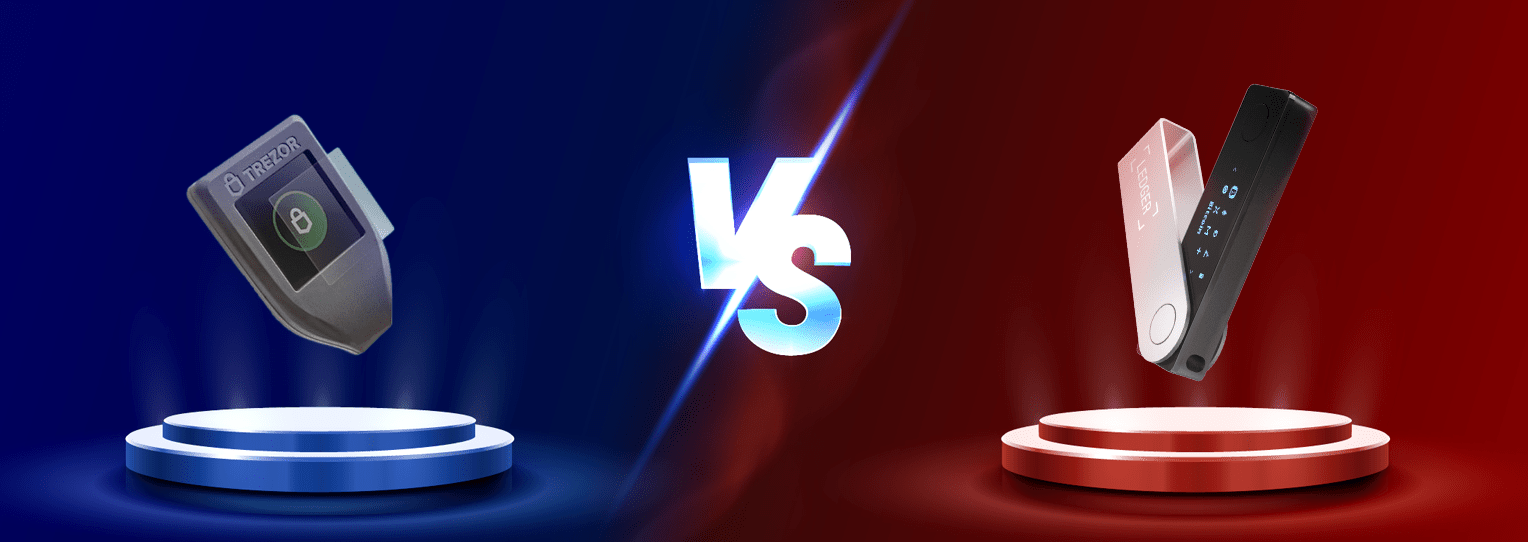
Hacking is a common issue with cryptocurrencies. One of the reasons for this is that crypto is a concept that predominantly exists online and serves the purposes of the internet. An offline way to store cryptocurrencies, known as cold storage, was developed to counter such hacking attempts. Ever since its invention in 2013, numerous hardware wallets have been developed. While we have a wide range of choices, today, we will compare two popular hardware wallets, Trezor vs. Ledger. Trezor is the world’s first-ever hardware wallet, and Ledger has sold over 300,000,000 million units worldwide.
Now that we have set the scene let’s move on to the comparison!
- What are hardware wallets?
- Why should you get a hardware wallet?
- What is a Trezor wallet?
- What is a Ledger wallet?
- Trezor Vs. Ledger Comparison
- Working of Trezor vs. Ledger Wallets
What are hardware wallets?
Hardware wallets are physical wallets used to store cryptocurrencies. The concept is similar to how we use physical wallets to store cash. Since the hardware wallets exist offline, they are free from possible attacks from hackers who might steal the cryptos online. This method of storing cryptos is called cold storage and contains private keys operated offline.
If you thought hardware wallets function like piggy banks where you drop crypto coins, you are wrong! To make the concept even more accurate, cryptocurrencies are never stored inside the hardware wallet. They always remain on the blockchain. The hardware wallet has one job, which is to store your private keys. The private key unlocks the address of your assets on the blockchain. This way, only you have the key to your cryptos and keep the keys offline.
Why should you get a hardware wallet?
As explained above, hardware wallets provide an extra layer of security. Here are some reasons why you should consider getting a hardware wallet if you don’t have one already!
Super Security
Hardware wallets keep your assets secured even if your computer has a virus. All the control will be in your hands, ensuring safety from malware, cyber-attacks, and phishing sites. These wallets are protected by an encrypted pin we generate so that the wallet self-destructs and logs out whenever a wrong password is entered. The private key is entered only on an encrypted hardware device, thus preventing any hacks.
One location for all your assets
You can store multiple assets and work with multiple blockchains in one hardware wallet. For example, you can manage Bitcoin, Ethereum, Alt Coins, Lumens, and more from the same wallet. You can also back up the assets with a single recovery tool.
Ease of use
If you didn’t already guess from the name, yes, the hardware wallet is a physical device. It is small, portable, and can be plugged in to access your cryptocurrencies anywhere. With one hardware wallet, you can log into multiple decentralized applications. You can even connect the wallet to general apps like Facebook and Google.
Trade between wallets
Using platforms such as Radar Relay, you can carry out transactions from one hardware wallet to another. In fact, this can be regarded as the safest way to trade assets as you regain custody and control over your assets at all times. This way, you can save time and transaction fees and surpass withdrawal limits.
Now, if you are convinced to get a hardware wallet, let’s move on to what we promised; comparing two of the most popular wallets, Trezor and Ledger.
What is a Trezor wallet?
Trezor is the first hardware wallet in the world, released as a part of SatoshiLabs, in 2013. The trezor hardware wallet has open-source firmware and software and supports over 1200 cryptocurrencies. Trezor is a single-purpose cryptocurrency wallet. The wallet helps store cryptocurrencies, manage digital identity and validate transactions. Trezor wallets can be connected to the computer via a USB cable to conduct online transactions. Trezor promises a 100% guarantee to protect all the assets in its wallet.
What is a Ledger wallet?
Ledger is a crypto hardware wallet with a custom operating system called Blockchain Open. Ledger has a popular offering, the Ledger Nano X, which supports more than 1800 cryptocurrencies. Ledger Nano is one of the gold-standard wallets available. Industry-specified features such as CC EAL5+ certified chips are integrated into Ledger wallets. Ledger is best known for its blockchain apps and security features.
Trezor Vs. Ledger comparison
Trezor and Ledger are both top names in the hardware wallet industry. They provide secure storage for your cryptocurrencies and support over 1,000 coins. Now let us look at their features based on their hardware, price, accessibility, and security.

Supported cryptocurrencies
Here Ledger has the upper hand as it supports more than 1800 cryptocurrencies and tokens. In contrast, Trezor supports around 1649 crypto coins and tokens.
Price
Trezor offers Trezor One Model and Trezor Model T, and Ledger Nano X and Ledger Nano S are the two devices of Ledger. Comparatively, Ledger NanoX is more affordable than Trezor. Ledger Nano costs around $120 per wallet. Trezor costs around $60 – $200 per wallet. The price difference is because Trezor Model T offers a colored touchscreen display.
Ease of use
Ledger and Trezor are user-friendly for both beginners and expert users. They have both simple setup processes where Ledger requires you to install the Ledger Live App, and Trezor works through a web-based interface. However, Trezor Model T has a color touchscreen, making it easier to enter the required details such as amounts and addresses you send crypto to and your pin code.
Security
A hardware wallet is always bought for its enhanced security, which is one of the primary factors of comparison. In Trezor wallets, the password is entered into the keyboard of a connected device, making it vulnerable to attacks. In Ledger, the password is linked to another PIN entered using the normal keys. Trezor uses a single chip base in the design of hardware wallets. In contrast, Ledger uses a double chip base, where the second chip is the financial-grade Secure Element chip. The Secure Element chip provides additional security against hardware attacks.
Compatibility
Ledger and Trezor are compatible with many apps, and we can choose the apps based on our requirements. The Ledger wallet is compatible with Ledger Live, Electrum, MyEtherWallet, Copay, Mycelium, Electron Cash, GreenBits, MyCrypto, Binance, Magnum, etc. Trezor, on the other hand, is compatible with apps such as MyTrezor, Copay, MultiBitHD, Magnum, GreenBits, Electrum, Mycelium, MyEtherWallet, etc.
Features
Both Trezor and Ledger have similar features. However, there are some subtle differences. The Ledger hardware wallet features a sleek design similar to a regular USB storage device. On the other hand, Trezor wallets are lighter in weight and have unique shapes with plastic casings. Ledger has the upper hand in features by offering support for iOS devices, a feature unavailable in Trezor wallets.
Physical appearance
Both the hardware wallets have a display screen to display phrases and send cryptocurrencies. Trezor has a large display screen, and its Trezor Model T has a color display touchscreen. Trezor is made from plastic, whereas the Ledger wallet comprises a stainless steel body. This makes the Ledger wallet more durable with a stylish overall look.
The Buttons on Trezor are easier to use as they have good space between them. In Ledger, the buttons are quite close, increasing the risk of pressing both simultaneously. Trezor is bigger than the Ledger Nano S; therefore, it is easier to carry a Ledger wallet than Trezor.
Hardware
The Trezor wallet has an ARM Cortex-M3 processor, and the screen resolutions vary based on its different models. The Ledger wallet has an operating system called BOLOS or Blockchain Open Ledger Operating system based on a dedicated chip called Secure Elements.
Working of Trezor vs. Ledger wallets
Most wallets have similar working processes. The working of Trezor and Ledger includes the following steps.
Step 1 – Plug the hardware wallet into your computer using a USB cable. Ledger Nano also supports Bluetooth connection.
Step 2 – Enable internet connection via your computer to the hardware wallet.
Step 3 – Download the desktop or mobile application of the respective wallets. Trezor comes with a desktop chrome extension too.
Step 4 – You can now start using the hardware wallet according to your requirement. For instance, you can transfer tokens from hot storage to cold storage. Or you can even transfer them to cryptocurrency exchanges directly.
Step 5 – After the full setup, you can view your crypto portfolio anytime on your phone or desktop.
Final Verdict
Both wallets are at par in their hardware and functionalities. When choosing one, you must know what you expect from the wallets, especially for your specific crypto practices. Hardware wallets are the most trustworthy and secure choice for storing and managing crypto assets. Both Ledger and Trezor are user-friendly and secure wallets with distinct value benefits. For example, Ledger Nano S is your best find if you are looking for a wider variety of crypto. If security is your concern, go for Trezor Model T. Therefore, evaluate your choices before you select your hardware wallets for your crypto ventures.


